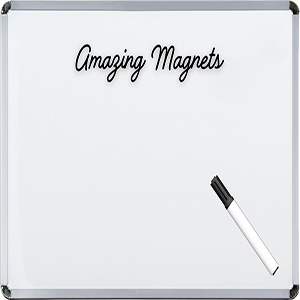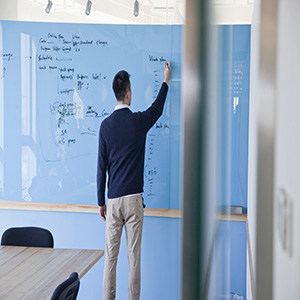Choosing Between Glass boards and Whiteboards: Which is Right for Your Workspace?
Listen to this Article
Whiteboards

Traditional whiteboards hold their ground with a familiar usability that many find comforting. They boast versatility in terms of size and installation options, which makes them a great choice for a wide range of environments and preferences. A whiteboard can cover an entire wall or can be a small, hand-held board for notetaking or a quick game of hangman in the car. The whiteboard is also very light allowing nearly anyone to move even a larger one from room to room. As with both of our options, the whiteboard’s strength lies in its ability to keep a space clean and organized. They also allow for a spectrum of color possibilities beyond the simple white of the chalkboard, making it easier to organize information and helping prevent whoever is using the board from being covered in clouds of white powder. One of the few downfalls of the whiteboard is that it must be regularly cleaned to avoid leaving smudges and colored “fog” on the board. The best way to prevent this from happening is to clean the board after every use and to avoid leaving writings or drawings on the board for too long.
Glass Boards

The glass board is like the whiteboard in many ways with the main difference being (you guessed it) a glass writing surface. Glass boards exude a sleek and modern aesthetic, elevating the ambiance of any workspace. Glass boards are favored in contemporary office environments for their smooth appearance and durability, adding a touch of sophistication and making a stylish statement. The boards can come in many different colors and different transparencies, allowing you to choose a board that fits the design of your space. Durability is another key advantage of glass boards. Unlike traditional whiteboards, which can become scratched or stained over time, glass boards are highly resistant to wear and tear. The non-porous surface of the glass is easy to clean and maintain, ensuring a pristine writing surface that retains its clarity and brilliance even with regular use. One downfall of the glass board is that it can be extremely heavy and may sometimes even require special installation.
Additional Factors to Consider Magnetic Capabilities
Considering magnetic capabilities is essential when selecting the appropriate board. While traditional glass boards may offer magnetic features as an add-on compared to traditional whiteboards, tempered glass inherently lacks magnetic properties. However, you can opt for glass boards with embedded magnets for a convenient display of documents and lightweight materials. In contrast, whiteboards are naturally magnetic, thanks to the metal backing beneath the smooth surface. Whether the board you are considering is magnetic or not is something to take note of.
Cost Considerations
If you are looking for a more budget-friendly option, whiteboards tend to offer a more friendly option compared to glass boards. However, while glass boards may require a higher initial investment, their durability and longevity can justify the upfront cost in the long run.
